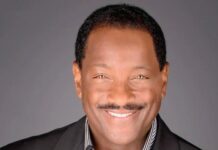
*Who knew that the beautiful dark-skinned man with the pretty pearly whites and effervescent smile was a maniacal marijuana user who cussed like a sailor?
Who would have thought that this man, who shared nothing but joy onstage while performing songs like “It’s a Wonderful World” and “Hello Dolly” was riddled with feelings of anger and angst when he wasn’t on stage?
Louis Armstrong is a national treasure, no doubt about that. And I’ll bet those reading this never even thought to wonder if the man who sang the iconic song, “What A Wonderful World” lived in this wonder at all.
After all, those old enough to recall became so accustomed to his big smile, gravelly voice and pleasant, nonthreatening demeanor, they probably never thought to look beyond it.
How could we not though?
This man was born in the gut of racial hatred and segregation. And he hit it big at a time when he couldn’t even walk through the front door of the venues he performed at.
But the white folks loved him (and still do from the majority of those in the audience on this night, which the actor portraying him acknowledges…as Louis, of course).
In my exclusive interview with John Douglas Thompson for EURweb, the actor speaks passionately about what his performance entails, and by the time we concluded the talk, I couldn’t wait to see the show! And I tell you, its going to be a real treat to learn about the man behind the smile. The man who made a conscious decision to spread joy and make people happy when he hit the stage.
“Satchmo at The Waldorf” is the story of the Louis Armstrong we never got to know while he was here. The play is Armstrong’s last public performance. It takes place in 1971 backstage at the Empire Room at the Waldorf Astoria Hotel in New York four months before he died in his hometown of Corona, New York.
And they couldn’t have found a more convincing actor to portray the jazz legend than Thompson, an Obie award-winning actor with a sterling pedigree; who brings Armstrong to life in this one-man production at the Wallis Annenberg Center for the Performing Arts (“The Wallis”) through Sunday, June 7.
The play, presented by the Long Wharf Theatre and Shakespeare & Company was penned by Terry Teachout, and directed by Long Wharf Theatre Artistic Director Gordon Edelstein.

Not only does the actor bear a strong likeness to the man himself, Thompson brings a rare and dynamic skill to the performance–playing three distinctly different characters: Armstrong, Joe Glaser, his Jewish manager of 40 years, and jazz musician Miles Davis, who was a thorn in Armstrong’s side, often alluding to him as an “Uncle Tom.”
Thompson skillfully and seamlessly weaves these multiple characters throughout. With the only external distinction in stage decor being lighting.
When I spoke on the phone with the actor and asked him if the play had reached its 100th performance, thinking out loud, he listed all of the venues the play has been performed at–some for months at a time: Off-Broadway at the Westside Theatre(four or five months), The Long Wharf Theatre, followed by performances at The Wilma Theater in Philly, and Shakespeare & Company. Now, with it being in Los Angeles at The Wallis, he states it has easily reached the 100th mark.
Thompson is a New Yorker in every sense of the word. And the first compliment I gave him was on his ability to engage in conversation; and thanked him because, as a fellow New Yorker (and Brooklynite) talking was not a weak point for him.
He gave. And gave. And gave…to my absolute delight!
Having done the show so many times, do you ever feel you’ve reached a plateau or do you still find new things to explore within the character.
I must say, I’m still in the process of discovery. You know it’s a lot of work doing a one person show. The only “other actor” on stage with me is the audience. So the show is constantly shifting and changing based on what the audience brings to it. The audience brings a certain amount of knowledge and understanding about Armstrong to it. And even with the most knowledgeable Armstrong fan, the play still brings a lots of vistas and avenues they are not aware of.
The actor says “thank God I live in New York” because it gave him access to the Louis Armstrong House Museum in Corona (Queens). Armstrong lived there with his wife, Lucille Wilson, from 1943 until his death in 1971. After his death it was turned into a museum.

Queens College also honors the musician by having an Archive Museum built. Fans and jazz enthusiasts can go and listen to the hordes of tapes (accompanied by transcripts) recorded by Louis Armstrong–who was truly ahead of his time when it came to using the technology that was available at the time to document his thoughts and plans.
Thompson says:
All the trumpets, handkerchiefs…all the various records, LPs. Everything he’s ever done, everything he’s ever written [is there]. What’s most important is that at the Archive Museum, they have all of his audio recordings. He was very big into audio technology and recorded everything: conversations, parties, concerts, interviews. He recorded all of it. It’s there.
It’s as if he knew it was going to be there for posterity, says Thompson about Armstrong’s desire to record everything.
Thompson says it was Terry Teachout, the playwright (and Drama Critic for the Wall Street Journal who also wrote a book on Armstrong) who first went in and analyzed the recordings.
He was the first to actually go in and listen to all of these recordings. And there are thousands of hours of audio tape that Terry kind of went through as part of his own research in the book. I also went through a majority of those tapes for my own research.
I was curious in the interview if Thompson had been a Louis Armstrong fan, who had looked for the opportunity to portray him one day. Or if this role simply came about and he decided to audition for it.
It was one of those things that, as an actor, you know we’re always looking for challenges within our craft. And the one thing I hadn’t done – I mean there are several things I haven’t done – but the one thing I hadn’t done and wanted to do was a one-person show. And I was also looking for material, interesting material that would be good to do for a one-person show.
So it was an opportune time. Terry Teachout said I have this play I’ve written on Armstrong just upon my research and the book I wrote about him and I used the book to help create a play. Would you like to do a reading of this play. I’d love for you to work on it.
From there, since the reading went so well, the two decided to formalize the relationship.
Thompson won the 2013-14 Drama Desk and Outer Critics Circle “Outstanding Solo Performance” awards for Satchmo at the Waldorf, and has been described by The New York Times as one of the most compelling classical stage actors of his generation.
Teachout is the author of Pops: A Life of Louis Armstrong. He was inspired to write the play, his first, after completing the book and says there were aspects of the musician’s life that evoked more questions, particularly his career-long dealings with his mob-connected manager, Joe Glaser.
Unsure how Armstrong really felt about the man who steered his career, Teachout felt there was a dramatic truth to be explored that was absent from the unembellished biographical record.
Armstrong’s legacy is a very rich one. He changed the sound of jazz, creating the language of jazz that we all know and recognize today. He was one of the two or three most influential and important jazz artists, and many critics claim his 1920s recordings with the Hot Fives and Sevens as the single most important recordings in jazz history — a kind of Declaration of Independence of jazz.
“For many white people in America,” Teachout says, “he was very likely the first black person they loved. He was someone they saw in movies, on television, and before that heard on the radio – someone who came into their homes. And that was an immensely important thing for a black man to have done.
He was the joyous entertainer who sang ‘Hello, Dolly!’ and ‘What a Wonderful World’ and made millions of people feel warm inside—but ‘Satchmo at the Waldorf’ is also about the private Armstrong, who swore like a trooper and knew how to hold a grudge. The fact that Satchmo (as he loved to call himself) had two sides to his personality doesn’t mean that the public man was somehow less real than the private one. Like all geniuses, Armstrong was complicated, and that complexity was part of what made his music so beautiful and profound,” Teachout states.
With regard to white people bringing the musician into their homes, at one point in the play Satchmo talks about having a decades long relationship with the beloved white singer, Bing Crosby. But he also adds that, in all that time, not unlike his manager Joe Glaser, he was never invited into their homes.

Thompson reveals it was his idea to clean take the trumpetad apart and clean it in the play. Since the play is mainly about Armstrong’s life offstage; audiences will get to hear glimpses of his music, but we also see him caring for his instrument. And the act of disembodying and cleaning his trumpet does not go unnoticed.
Many of us have never seen a trumpet taken apart. And Thompson does even this, lovingly.

Thompson says that in the end, doing a solo show is very rewarding.
The process of doing a one-person show is very challenging. You don’t have the advantages of other actors with you on stage. It’s you generating the pace, the interest, the narrative. It’s all you–the single performer, with the audience. It’s very difficult and it requires a lot of mental, physical and emotional stamina to get through the process.
It’s also very rewarding at the end of it because there’s an accomplishment of bringing something to life on stage; of bringing a story that maybe no one has really fully investigated. This is a less heralded part of Louis Armstrong’s life. His relationship with his manager and how that shaped and controlled his legacy and his destiny. And the price of that.
Thompson plays Armstrong at the age of 71, four months before the musician passed away (in the year 1971, did you catch that?). And he says it is at a time when the musician is wrestling with the choices that he has made.
So he’s wrestling with his legacy. The choices that he’s made; some of them great and some of them maybe weren’t so great. So maybe he had to pay a price for that.
Can you speak about Armstrong’s relationship to the black community. I know many African Americans and other jazz musicians such as Miles Davis, considered him more of an “Uncle Tom. And this is why Miles is one of the characters in the play. But he represents more of a ‘movement’ of people who felt this way towards the musician. How did Armstrong handle this?
One of the things the play goes into was the pain he felt by being termed ‘Uncle Tom.’ And it caused a reactionary response in him to try to say, ‘I’ve done this, and I’ve done that.’ And ‘how could someone call me an uncle Tom after the commitment I made to my people and the stuff that I’ve done for civil rights.
Thompson reveals there are several areas in the play that deal with racism. Both the racism stemming from Jim Crow whites as well as the challenges Armstrong faced from his own people.
And the Miles Davis [thing] is just one aspect of it…There are many civil rights things that Armstrong did that is somewhat under the radar. And when you look at them, put them under a microscope you say ‘wow, that was really huge.
It is because of Armstrong, and what he went through at the time; the racism involved in the music industry, and eventually being able to stay in the same hotels he played in that broke barriers and enabled musicians coming up behind him to enjoy this benefit today.
There was a certain amount of frustration in Armstrong for never having received the credit for creating that situation for others. In his private side, he really did have that kind of animosity.
When we think of Louis Armstrong we always smile. [We think about] that handkerchief. What we’re trying to say is there was something behind that. There was a very complex figure behind that, that most people don’t know or understand. That complex figure was affected by racism, the commercialism of the music industry. He was also politically motivated in many situations.
Following The Wallis engagement, “Satchmo at the Waldorf” travels to Chicago’s Court Theatre, Palm Beach Dramaworks, and San Francisco’s American Conservatory Theatre during the 2015-16 season.
The performance runs through Sunday, June 7, 2015. And shows are Tuesday – Friday at 8:30 PM; Saturdays at 3:30 PM and 8:30 PM; Sundays at 2:30 PM and 7:30 PM.
Running time is 90 minutes with no intermission.
This production contains strong, adult language. Suggested for mature high school students and up.
Ticket prices range from $30.00 – $50.00
Tickets can be purchased in person at the Wallis Annenberg Center for the Performing Arts: Ticket Services, 9390 N. Santa Monica Blvd, Beverly Hills, CA 90210. By phone at 310-746-4000 or Online by visiting www.thewallis.org.
We Publish News 24/7. Don’t Miss A Story. Click HERE to SUBSCRIBE to Our Newsletter Now!





